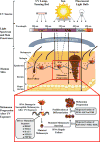Melanoma Chemoprevention: Current Status and Future Prospects
- PMID: 28295364
- PMCID: PMC5500429
- DOI: 10.1111/php.12749
Melanoma Chemoprevention: Current Status and Future Prospects
Abstract
The incidence of skin cancers, both nonmelanoma and melanoma, is increasing in the United States. The ultraviolet radiation, mainly from sun, is considered the major cause for these neoplasms. While nonmelanoma skin cancers are far more numerous, melanoma remains the most challenging. This is because melanoma can become extremely aggressive and its incidence is increasing worldwide due to lack of effective early detection, as well as disease recurrence, following both surgery and chemotherapy. Therefore, in addition to better treatment options, newer means are required to prevent melanomas from developing. Chemoprevention is a reasonable cost-effective approach to prevent carcinogenesis by inhibiting the processes of tumor initiation, promotion and progression. Melanoma is a progressive disease, which makes it very suitable for chemopreventive interventions, by targeting the processes and molecular pathways involved in the progression of melanoma. This review discusses the roles of various chemopreventive agents such as NSAIDs, statins, vitamins and dietary agents in melanoma and highlights current advancements and our perspective on future of melanoma chemoprevention. Although considerable preclinical data suggest that melanoma may be prevented or delayed by a numerous chemopreventive agents, we realize there are insufficient clinical studies evaluating their efficacy and long-term safety for human use.
© 2017 The American Society of Photobiology.
Figures


Similar articles
-
[Sunbathing habits and risk of melanoma].Ugeskr Laeger. 2000 Jun 5;162(23):3307-10. Ugeskr Laeger. 2000. PMID: 10895595 Review. Danish.
-
Rising trends in melanoma. An hypothesis concerning sunscreen effectiveness.Ann Epidemiol. 1993 Jan;3(1):103-10. doi: 10.1016/1047-2797(93)90017-x. Ann Epidemiol. 1993. PMID: 8287144 Review.
-
Primary and Secondary Chemoprevention of Malignant Melanoma.Am J Clin Dermatol. 2016 Dec;17(6):625-634. doi: 10.1007/s40257-016-0221-5. Am J Clin Dermatol. 2016. PMID: 27665299 Review.
-
Epidemiology of melanoma: is it still epidemic? What is the role of the sun, sunbeds, Vit D, betablocks, and others?Dermatol Ther. 2012 Sep-Oct;25(5):392-6. doi: 10.1111/j.1529-8019.2012.01483.x. Dermatol Ther. 2012. PMID: 23046017
-
Trends in melanoma incidence among children: possible influence of sun-protection programs.Expert Rev Anticancer Ther. 2011 May;11(5):661-4. doi: 10.1586/era.11.28. Expert Rev Anticancer Ther. 2011. PMID: 21554037 No abstract available.
Cited by
-
Chemoprevention agents for melanoma: A path forward into phase 3 clinical trials.Cancer. 2019 Jan 1;125(1):18-44. doi: 10.1002/cncr.31719. Epub 2018 Oct 3. Cancer. 2019. PMID: 30281145 Free PMC article. Review.
-
SNHG5 promotes proliferation and induces apoptosis in melanoma by sponging miR-155.RSC Adv. 2018 Feb 7;8(11):6160-6168. doi: 10.1039/c7ra12520h. eCollection 2018 Feb 2. RSC Adv. 2018. Retraction in: RSC Adv. 2022 Sep 7;12(39):25279. doi: 10.1039/d2ra90086f. PMID: 35539582 Free PMC article. Retracted.
-
Etiologies of Melanoma Development and Prevention Measures: A Review of the Current Evidence.Cancers (Basel). 2021 Sep 30;13(19):4914. doi: 10.3390/cancers13194914. Cancers (Basel). 2021. PMID: 34638397 Free PMC article. Review.
-
Knockdown of circular RNA hsa_circ_0062270 suppresses the progression of melanoma via downregulation of CDC45.Histol Histopathol. 2022 Apr;37(4):373-383. doi: 10.14670/HH-18-412. Epub 2021 Dec 21. Histol Histopathol. 2022. PMID: 34931691
-
CRISPR/Cas9-mediated Knockout of SIRT6 Imparts Remarkable Antiproliferative Response in Human Melanoma Cells in vitro and in vivo.Photochem Photobiol. 2020 Nov;96(6):1314-1320. doi: 10.1111/php.13305. Epub 2020 Jul 24. Photochem Photobiol. 2020. PMID: 32621766 Free PMC article.
References
-
- Spagnolo F, Queirolo P. Upcoming strategies for the treatment of metastatic melanoma. Arch Dermatol Res. 2012;304:177–184. - PubMed
-
- Siegel RL, Miller KD, Jemal A. Cancer Statistics, 2017. CA Cancer J Clin. 2017;67:7–30. - PubMed
-
- Markovic SN, Erickson LA, Rao RD, Weenig RH, Pockaj BA, Bardia A, Vachon CM, Schild SE, McWilliams RR, Hand JL, Laman SD, Kottschade LA, Maples WJ, Pittelkow MR, Pulido JS, Cameron JD, Creagan ET, C. Melanoma Study Group of the Mayo Clinic Cancer Malignant melanoma in the 21st century, part 1: epidemiology, risk factors, screening, prevention, and diagnosis. Mayo Clin Proc. 2007;82:364–380. - PubMed
-
- Almutawa F, Buabbas H. Photoprotection: clothing and glass. Dermatol Clin. 2014;32:439–448, x. - PubMed
Publication types
MeSH terms
Substances
Grants and funding
LinkOut - more resources
Full Text Sources
Other Literature Sources
Medical

